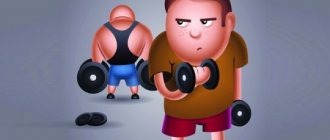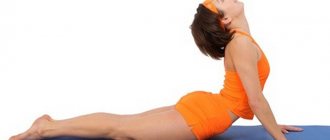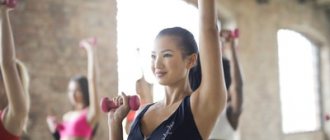Starting to practice yoga on your own is not as difficult as it seems at first glance. This sport is now very popular and fashionable, as it allows you to put in order not only your body, but also your thoughts. Many techniques and levels of difficulty of asanas allow you to choose the appropriate option for any purpose. But to get at least minimal results, you need to not just watch the video, but start practicing on your own.
Types of yoga for beginners
- Ashtanga. An energetic and intense look that will not let you relax. One lesson consists of several poses lasting five breathing cycles. Between them, a “sun salutation” must be done.
- Mysore. The safest variety. The average duration is 3 hours, but you can come and go as you please, take breaks, and maintain your own pace, not the instructor’s pace. The demonstrated asanas can be repeated as many times as required.
- Vinyasa flow. Just business, no unnecessary information about the muscle groups that work, the benefits, effects, designations of asanas. This is a complete immersion in the inner world, as well as high intensity exercise.
- Bikras. This species was created in the 70s of the last century. It consists of exactly 26 asanas that strengthen muscles, develop body stretching, and compress internal organs. In order to get rid of toxins, the air in the room is heated (sauna effect). Therefore, you will have to work hard.
- Kundalini. The basis of this knowledge is working with the spine, its restoration, and support. Traditional asanas are complemented by breathing practices and meditation.
- Hatha. No meditations, mantras, breathing techniques, only physical activity through asanas.
- Yin. An excellent option for those people who lead a sedentary lifestyle or do not move much. The yin variety relieves tightness and stiffness in the muscles, increases flexibility and elasticity. The duration of one asana can be up to 10 minutes. Thanks to meditation, this type is often chosen by athletes before serious competitions.
- Jivamukti. Includes reading, listening to special musical compositions, doing vinyasa poses, and singing. This direction is considered a separate philosophy that allows you to get rid of unnecessary things.
All types are aimed at relaxation, getting rid of stress, gaining knowledge and skills to understand your body. But some focus on stretching, others on posture and back health, and strength exercises. You must first understand why you should start doing yoga in order to choose a specific type and focus completely on it.
Tip 1. Choosing a corner for practice
When doing yoga, you should be in complete harmony with yourself. Nothing should distract or irritate you. For complete convenience, before starting classes, arrange for yourself a special place where you can calmly perform the exercises. Decorate it in a certain style, hang paintings, photographs or add other things that lift your spirit. Place flowerpots with beautiful plants.
It’s good if this “corner” is near the window so that you can receive maximum light and solar energy. It is important that in the part of your home where you are planning activities, there is no unnecessary furniture or other objects that could cause injury.
Is it possible to learn yoga on your own?
According to experienced experts, if there is no opportunity or desire to visit the gym, you can always practice at home. You just need to select asanas that will match your experience and not jeopardize your health. If you have no experience at all, you can attend several classes with an instructor to understand the structure of the classes and the features of a particular direction.
While practicing at home, do not forget about a number of recommendations and rules that will help you do everything right and constantly develop your body and thoughts.
- Safety comes first. Many exercises are quite traumatic; you need to start with the simplest basics with detailed video tutorials. Only if the body completely gives in, and the position of the legs and arms is learned, can you move on to the next stage.
- You can't do without a warm-up. As in any sport, proper warm-up allows you to warm up your muscles and joints and prepare them for stress. Warm-up should include exercises for all muscle groups.
- It is better to do yoga on an empty stomach. That is why the morning time or two hours after breakfast is suitable. Due to compression of the organs, the body may reject undigested food.
- Contraindications. If there are inflammatory processes, open wounds, infectious diseases, acute respiratory viral infections, exacerbation of chronic diseases, menstrual periods or stomach pain, you should postpone classes until next time.
- Stable schedule. You cannot start yoga classes on your own, and then take a break for two months and continue from the same place again. The body forgets about its achievements. If you are interrupted, you need to start from scratch. Create a schedule that is convenient for you and follow it constantly. For example, it is better to study every other day for half an hour than just twice a week for three hours.
In addition, it is important not to forget about moderation. You should not try asanas shown by trained bloggers or experienced athletes if they are of a difficult level. Everything has its time: beginners should learn at least 20 simple asanas and meditation in order to move on.
Benefits of self-paced lessons
To start practicing, you just need to carefully prepare, and no matter how trivial it may sound, just start. Above, we discussed in detail the question of how to do yoga at home correctly. Now it’s worth getting acquainted with the obvious advantages that classes bring in your own, comfortable territory:
- Own schedule . The pace of life often does not contribute to additional stress and self-education. Doing exercises at home will make the schedule for working out special poses as convenient as possible;
- Minimum expenses. Having purchased everything once, you will no longer need to pay for anything;
- Creating a personalized atmosphere . Yoga is a rather intimate topic, so pleasant physical and spiritual exercise accompanied by soothing music will benefit a person.
Some yoga practitioners believe that it is better to conduct classes in the evening, others advocate a morning set of exercises. In any case, it is better to decide in advance what yoga is for this particular person. And you can exercise at any time, but not on a full stomach.
Where to start at home?
There are a number of recommendations and steps that will help you quickly and easily start learning yoga at home.
- Choose a place to practice. You need to be in complete harmony with yourself in order to practice. Therefore, everything around should bring peace, and not irritate. This could be in the bedroom near the bed, in the corner of the living room or even on the balcony. The main thing is that there are no distractions. Choose a seat near a window with plenty of natural light.
- Arrangement of the place. First of all, you need to purchase a special mat for yoga classes. It can be made of synthetic, natural, or combined materials, and must be suitable in size. There should be no furniture around the chosen place that could cause injury. Over time, the corner can be decorated with photographs, cute things, and motivational images. Other activity accessories can be purchased later when needed. These include a meditation blanket, knee pads, smart sports sensors with a timer and the ability to control pressure, pulse, and body temperature.
- Drawing up a nutrition plan and training schedule. It is compiled taking into account work, family, sleep patterns, etc. There are no clear boundaries when you can and cannot exercise. The main thing is that it is comfortable for the body and does not cause stress. The meal schedule is also selected based on the time of classes.
- Choice of style. There are a lot of them, options for beginners have already been mentioned. Before choosing, you should read about the purpose of each type, what advantages, features, and whether it will help achieve a specific goal. There is no need to rush, since further development depends on the first direction. Information is available in specialized books and websites. But it is best to contact a professional instructor at the club. Most often, beginners prefer Ashtanga and Hatha yoga, which are considered the simplest and safest.
- Choice of exercises. Even after choosing a specific type of practice, several dozen asanas are offered, which differ greatly from each other. Building a program on your own is difficult, but possible. In addition, there are special mobile applications that greatly simplify this task. You can also ask your coach for advice.
- Select music or background. It is believed that it is better to concentrate in silence. But that's not true. The sounds of a house, apartment, neighbors, street, and even drops of water from a tap can throw you off balance. A special selection of music for relaxation allows you to forget about extraneous sounds and focus on a certain rhythm and tempo. In addition, some compositions help achieve peace of mind.
Yoga as a way of life is pleasure and balance. If it leads to irritation, pain, or other problems of a physical or moral nature, you need to change direction or even choose a completely different sports activity. And if after training there are only good impressions, the vector of movement has been chosen correctly.
Some restrictions
Yoga, like any other serious complex, has its contraindications. Classes are contraindicated when there is an inflammatory process in the human body, with intervertebral hernias of the back, with infectious diseases, influenza and ARVI, with cancer, with any pain and acute conditions, with serious problems with blood pressure, kidneys, and heart.
If you do asanas in an absent-minded state, then at best you may simply not achieve the desired effect, at worst you may pull a muscle. It is also not advisable to rush to increase the load and duration of classes.
Doing asanas, pranayama (breathing exercises) and meditation correctly means giving your body a second chance at health and lightness. Despite its apparent simplicity, yoga brings serious changes to a person’s life, which requires moral preparation and a clear schedule. Then yoga for beginners will become something everyday, ordinary and joyful.
Breath
Breath control is fundamental to any practice. It should be calm, deep, rhythmic. Inhalations and exhalations are made full, measured, with intervals between cycles. Beginners are advised to use a metronome to set the desired tempo. At first you will have to constantly monitor your breathing, but then it will return to normal. If you skip this stage and do asanas as best you can, then there will be no effect. Even leisurely yoga in hammocks, without breathing, is just gymnastics.
How is yoga different from gymnastics?
Yoga in the full meaning of the word presupposes a special way of life, following which you can achieve complete enlightenment and absolute harmony in everything.
A person who decides to seriously take up yoga must understand: now he will have to reconsider his life principles, say goodbye to bad habits (alcohol, smoking and yoga are incompatible things), and it will take a lot of time to master the practice, so you should be patient.
Yogic teaching requires a rethinking of life principles, the ability to control one’s emotions and feelings through meditation and concentration. Without this, simple yoga at home will turn into ordinary gymnastics with a set of specific exercises aimed at improving the functions of certain organs and forming an ideal figure.
Warm-up
Warming up before asanas is somewhat different from the standard one. The first part is more like a regular exercise for all muscle groups. But towards the end, the movements become smoother and calmer. The purpose of a warm-up is to first warm up the muscles so that they begin to work, and then calm them down. Already at this stage you need to use correct breathing. To relax between warm-up and asanas, you can use meditation, learning mantras, and calm music.
Tip 6. Walk to success slowly
No matter what kind of physical shape you are in, you can always do yoga. But! Adjust the load. Start small and gradually increase the time allotted for training. And remember, yoga was not created for weight loss or as another type of fitness. Yoga is a way to achieve spiritual balance, a path to self-knowledge and body cleansing. This takes a lot of time, don’t rush things. In addition, many asanas require good physical fitness. If you try to catch them ahead of time, you risk serious injury.
Simple asanas that you can do yourself
- Simple basics. Everything in yoga originates from it. Beginners need to sit on the mat with their legs stretched out in front of them. Place each foot under the opposite knee. Bend your lower back slightly forward, straighten your back. This base is used for breathing, meditation and other asanas.
- Rock. Also applies to the main ones. You need to sit on your knees and put your hands on your hips. The back remains straight. Your ankles will hurt first, so you can put a blanket under your buttocks.
- Mountain. Stand straight, feet shoulder-width apart, lower back and stomach tense and straight. Shoulders and chest are straightened. As you inhale, your hands rise up and touch your fingers and continue to stretch. The stand should be firm and not wobble.
- Triangle pose, better known as downward-facing dog. From a standing position with your arms and legs shoulder-width apart, move to resting your feet and palms on the floor. All limbs are straight, the neck is elongated, the back is as straight as possible. The body should form a triangle. The initial duration is one minute, but ideally the asana should last at least 4 minutes.
- Cat-cow pose. The initial pose is on all fours. Place your hands shoulder-width apart and your knees under your hips. As you inhale, begin to pull your pelvis forward, smoothly bending your back down. The chin stretches as high as possible. This is the cow pose from which you need to move into the cat pose. To do this, as you exhale, you need to start moving your pelvis, your back in the opposite direction, and rest your chin on your chest.
- "Cobra". An excellent asana for training your shoulders and chest. Lie on your stomach, place your hands under your shoulders. Slowly raise your head, neck, and chest until your arms are fully straightened. In this case, the body should move backward. If at first it is difficult to hold on to your outstretched arms, you can slightly bend your elbows. Hold the pose for 1 to 3 minutes.
- "Tree". Another basic asana that everyone should learn. Starting in Mountain Pose, lift one leg and place the sole of the foot on the thigh of the other leg. Pull your stomach in, straighten your back, raise your arms up and join them with your palms. Hold this for several breathing cycles. Repeat for the other leg.
These are just a few asanas that make up the basic framework of yoga. It will take a lot of time to master them, since they only seem easy at first glance. In addition, you need to constantly monitor not only your movements, but also your breathing.
Tip 3. Decide on a yoga style
There are quite a lot of styles of yoga, and before you start full-fledged classes, you should decide which direction is most suitable and appealing to you. How to find out? The easiest way is to attend group classes and communicate with experienced practitioners. It is not necessary to buy subscriptions, if this is not your thing, you will learn about it during the trial lesson.
Hatka yoga is considered the most widespread and popular. Beginners are recommended to start their journey with Ashtanga Vinyasa yoga. Kundalini yoga is suitable for lovers of active and dynamic activities. Pregnant women and those who are afraid of getting injured should start with B.K.S yoga. Iyengar. The choice of yoga style also depends on the goals you are pursuing: you are looking for a path to self-knowledge, you want to lose weight, you want to improve your health, etc.
When should you go to a yoga center?
Yoga classes in St. Petersburg are now very well attended and popular, so finding an option that is in harmony with your inner state is quite easy. There is plenty to choose from. If home lessons do not give any results, self-discipline is poor, it is better to go to an instructor with professional training and study in a group. The support of other athletes and the opportunity to quickly learn will improve not only your mood, but also the level of your body’s preparation for new asanas. The body will respond to regular, well-constructed exercises with progress. The result will become more noticeable, which will encourage you and give you hope to become an advanced yogi.
Is it possible to lose weight with yoga?
If you want to quickly lose weight with the help of home yoga, then I hasten to disappoint you. Yoga is not the best or fastest way to lose weight. Of course, without a doubt, yoga can increase metabolic processes in the body, which will allow you to lose extra pounds, but this process is very lengthy. The effect on your figure from yoga should not be expected within a few weeks; months of practice must pass before you notice changes in your figure. However, to increase the effect of home yoga for weight loss, follow the principles of proper nutrition, lead an active lifestyle and conduct regular yoga sessions.
Preparation for classes
To achieve your goals and avoid injuries, you need to prepare for each lesson.
Do some stretching exercises before class.
Correct breathing
At the beginning of the journey, you need to learn how to breathe correctly. This will reduce the chance of injury and help you achieve greater results from your workouts.
- Breathing occurs through the nose.
- When bending, exhale, and when bending, inhale.
- Breathing should be measured, slow and deep.
- During the process, the abdominal muscles are tense.
Breathing correctly is an important part of yoga.
Warm up for the body
Before training, it is necessary to warm up the ligaments and muscles to prevent damage. This can be done by going to a bathhouse or sauna, or doing physical activity (running, cycling, walking at a fast pace).
For this purpose, a special yogic complex “Sun Salutation” is used, consisting of 12 asanas.
Before trying yoga on your own, it is recommended to take a meditation course. Such training will help you properly relax before practice, get rid of tension in the body, and increase your ability to concentrate.
Tip 8. Regularity
It doesn’t matter for what purpose you decide to start practicing yoga, and what success you want to achieve, your practices should be regular. In this, yoga is absolutely no different from any sports. Maintain discipline and then you will reap the rewards of your efforts. You shouldn’t throw yourself into classes at the very beginning; save your energy for further training.
Experts are of the opinion that it will be enough for beginners to exercise only 15 minutes twice a week. This is the only way your inspiration and motivation will remain for a long time. Try not to miss practices, especially since modern technologies allow you to practice anywhere and in any conditions. Just a quarter of an hour is enough to change your life, is that a lot?










